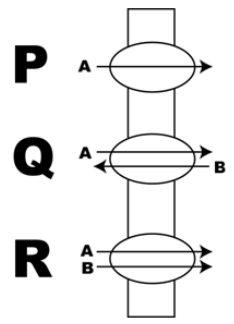12th Grade > Biology
TRANSPORT IN PLANTS MCQs
Total Questions : 74
| Page 7 of 8 pages
Answer: Option D. -> Guttation
:
D
The loss of water in the form of droplets through hydathodes, specialized pores present on the leaf margins and apex is known as guttation.
:
D
The loss of water in the form of droplets through hydathodes, specialized pores present on the leaf margins and apex is known as guttation.
Answer: Option D. -> P - Uniport, Q - Antiport, R - Symport
:
D
Uniport is the transport of one molecule at a time, whereas, in symport,two molecules are transported at a time in the same direction and in antiport, the molecules are transported at a time in opposite directions.
:
D
Uniport is the transport of one molecule at a time, whereas, in symport,two molecules are transported at a time in the same direction and in antiport, the molecules are transported at a time in opposite directions.
Answer: Option C. -> C14
:
C
'Translocation of food' basically means transport of organic solutes especially sugars such as glucose, and other organic molecules. This takes place primarily through the phloem. These organic molecules can be tracked using the Carbon-14 isotopeC14.
:
C
'Translocation of food' basically means transport of organic solutes especially sugars such as glucose, and other organic molecules. This takes place primarily through the phloem. These organic molecules can be tracked using the Carbon-14 isotopeC14.
Answer: Option D. -> Water comes out of the cell by exosmosis, causing it to shrink
:
D
The salt solution being hypertonic, the water potential of the salt solution is less than that of the cytoplasm of the cell. Hence water comes out of the cell through osmosis and protoplast shrinks.
:
D
The salt solution being hypertonic, the water potential of the salt solution is less than that of the cytoplasm of the cell. Hence water comes out of the cell through osmosis and protoplast shrinks.
Answer: Option D. -> All
:
D
Carrier proteins being highly selective, they are liable to saturate, respond to inhibitors and are influenced by hormonal regulation.
:
D
Carrier proteins being highly selective, they are liable to saturate, respond to inhibitors and are influenced by hormonal regulation.
Answer: Option D. -> All of these
:
D
All minerals cannot be absorbed passively. Minerals are usually present as charged ions and the concentration of minerals is more in the root than in soil. Hence to cross the membranes they require energy in the form of ATP.
:
D
All minerals cannot be absorbed passively. Minerals are usually present as charged ions and the concentration of minerals is more in the root than in soil. Hence to cross the membranes they require energy in the form of ATP.
Answer: Option A. -> True
:
A
The water absorbed by the plant from the soil through root system is lost into the atmosphere through the shoot system which in turn gets back to the soil through rains.
:
A
The water absorbed by the plant from the soil through root system is lost into the atmosphere through the shoot system which in turn gets back to the soil through rains.
Answer: Option C. -> Both a & b
:
C
Transpiration occurs mostly through stomata located on leaves. It also occurs through cuticle and lenticels. Foliar transpiration is the term given to transpiration that occur from the leaf surfaces, which includes the loss of water vapor through stomata and cuticles. Lenticels being present mainly in the stems and branches do not form a part of foliar transpiration.
:
C
Transpiration occurs mostly through stomata located on leaves. It also occurs through cuticle and lenticels. Foliar transpiration is the term given to transpiration that occur from the leaf surfaces, which includes the loss of water vapor through stomata and cuticles. Lenticels being present mainly in the stems and branches do not form a part of foliar transpiration.
Answer: Option A. -> Hypertonic solution only
:
A
Cell wall is completely permeable to solvent and solutes. Plasmolysis occurs when water moves out of the cell and resulting in the shrinkage of cell membrane away from the cell wall.In a plasmolysed cell external solution i.e., hypertonic solution will be present in between plasma membrane and cell wall.
:
A
Cell wall is completely permeable to solvent and solutes. Plasmolysis occurs when water moves out of the cell and resulting in the shrinkage of cell membrane away from the cell wall.In a plasmolysed cell external solution i.e., hypertonic solution will be present in between plasma membrane and cell wall.
Answer: Option A. -> A to B
:
A
ψw of cell A = -0.8+0.6 = - 0.2 MPa ψ of cell B = -0.7+0.4= - 0.3 MPa. Water moves from higher ψw value to lower Ψw value. Hence it moves from A to B
:
A
ψw of cell A = -0.8+0.6 = - 0.2 MPa ψ of cell B = -0.7+0.4= - 0.3 MPa. Water moves from higher ψw value to lower Ψw value. Hence it moves from A to B

















